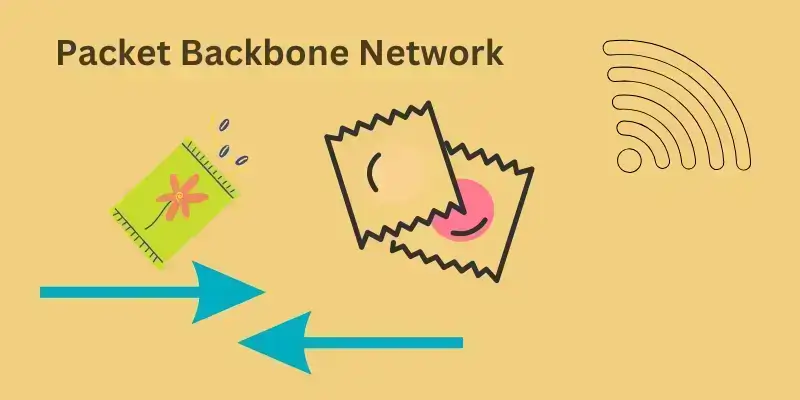Packet Backbone Network
Published: January 29, 2025
A packet backbone network is like the main road for data to travel across the internet. When we send or receive data online, it’s broken into small pieces called “packets.” These packets travel across many different networks to reach their destination. Backbone networks are the highways that connect various parts of the internet, helping packets move quickly and efficiently.
In this blog, we’ll examine how packet backbone networks work, their benefits, and their use in everyday life.

What is a packet backbone network?
A packet backbone network is a high-speed central network that transfers data in small packets across different systems. It ensures efficient and fast data transmission between networks and devices.
Key Components of a Packet Backbone Network
A Packet Backbone Network connects different network segments, allowing data to flow efficiently over long distances. The key components of this network are vital to ensuring seamless communication and data transfer. The following are its key components:
- Routers and switches (Their roles in forwarding packets)
- Transmission medium (fiber-optic cables, microwave, etc.)
- Network protocols (TCP/IP, MPLS, etc.)
- Network interfaces and edge devices
1. Routers and Switches: Their Roles in Forwarding Packets
Routers
These devices operate at the network layer and determine the best route for data packets to travel. They forward packets based on the destination IP address, ensuring data reaches the correct network.
Switches
At the data link layer, forward data packets within local networks using MAC addresses are switched. They ensure efficient communication between devices within the same network segment.
2. Transmission Medium
Fiber-Optic Cables
These cables offer high-speed data transmission over long distances with minimal signal loss, making them ideal for backbone networks.
Microwave Links
Wireless communication through microwave links is used when physical cables are impractical. They provide reliable data transfer for remote areas.
Other Media
Transmission can also occur over copper cables, satellite links, or other wireless technologies, depending on the network’s needs and location.
3. Network Protocols
TCP/IP (Transmission Control Protocol/Internet Protocol)
This suite of protocols governs how data is transmitted across networks, ensuring reliable delivery by handling packet loss and error correction.
MPLS (Multiprotocol Label Switching)
MPLS improves the speed and efficiency of data transfer by assigning labels to packets. These labels help routers make faster forwarding decisions, reducing delays in high-traffic networks.
4. Network Interfaces and Edge Devices
Network Interfaces
These are the physical or virtual interfaces that connect devices to the backbone network. They can be wired (Ethernet, fiber) or wireless (Wi-Fi, cellular).
Edge Devices
Devices like computers, servers, and network switches act as entry and exit points to the backbone network. They connect local networks or users to the broader backbone infrastructure.
Together, these components ensure that data flows efficiently across a packet backbone network, allowing for robust communication across diverse network environments.
How Packet Backbone Networks Work
Packet backbone networks efficiently transmit data by dividing it into smaller units and using advanced routing techniques. Here’s a breakdown of how they work:
1. Packetization of Data
Breaking Data into Packets
Large data, such as files or messages, is divided into smaller packets. Each packet contains part of the original data along with essential information, such as the destination address and sequence number.
Why It’s Done
This makes sending large amounts of data across the network more manageable, allowing for better handling of network traffic and minimizing congestion.
2. Routing and Forwarding Packets Through Multiple Network Nodes
Routers and Switches
Routers and switches are responsible for forwarding the packets through various network nodes. Each packet may take a different path based on the current network conditions.
Routing Process
Routers read the destination IP address in the packet’s header and decide the best path for forwarding. This process continues across multiple network nodes until the packet reaches its destination.
3. Reassembling Packets at the Destination
Reassembly Process
Once all the packets reach the destination, they are reassembled into the original data. The sequence numbers in each packet ensure they are put in the correct order.
Error Checking
If any packets are lost or corrupted, the receiving system can request that they be resent, ensuring the integrity of the data.
Advantages of Packet Backbone Networks
Packet backbone networks offer several advantages that make them ideal for modern, high-demand communication systems. These benefits include scalability, flexibility, redundancy, and cost-effectiveness.

Scalability
Packet backbone networks can quickly scale to handle increasing users and growing data traffic. As demand for network capacity rises, new routers, switches, and transmission links can be added without significant disruptions to the network. This scalability ensures the network can support more devices and users without sacrificing performance.
Flexibility
One significant advantage of packet backbone networks is their ability to support multiple types of communication. Whether it’s voice, video, or data, packets can carry all forms of communication. This versatility allows businesses and service providers to use a single network for various services, reducing the need for separate infrastructures for each type of communication.
Redundancy
Packet networks are designed with redundant paths to ensure reliability. If one path fails due to a network issue or hardware malfunction, the packets can be automatically rerouted through an alternative route. This redundancy ensures that communication continues without interruptions, even in a failure.
Cost-Effectiveness
Packet switching optimizes the use of network resources, resulting in lower operational costs. The network’s bandwidth is used more efficiently because data is split into small packets and can be routed through various paths. It reduces the need for expensive dedicated lines and helps cut down on costs related to infrastructure and maintenance.
Challenges of Packet Backbone Networks
Despite their numerous advantages, packet backbone networks face challenges requiring careful management to ensure smooth performance.
Congestion
Network congestion occurs when there is too much data traffic for the network to handle, leading to delays, packet loss, and decreased performance. High traffic can overwhelm routers and switches, causing packets to be dropped or delayed. Proper traffic management and load balancing are necessary to avoid congestion.
Latency
Latency refers to the time it takes for packets to travel from the source to the destination. In packet backbone networks, latency can increase due to factors like long-distance transmission, network congestion, or router processing delays. High latency can affect real-time communication services like voice and video calls.
Security
Security risks such as packet sniffing and data breaches concern packet-switched networks. Unauthorized individuals can intercept data packets traveling across the network, potentially accessing sensitive information. Implementing encryption and secure communication protocols is essential to safeguard data.
Managing Quality of Service (QoS)
Managing Quality of Service (QoS) can be challenging in packet backbone networks, especially when supporting multiple types of traffic like video, voice, and data. Different applications have different latency and bandwidth requirements, and ensuring that these needs are met without disrupting other services requires careful planning and traffic prioritization.
Use Cases of Packet Backbone Networks
Packet backbone networks are vital in ensuring seamless communication across various industries. Below are some key use cases:
Internet Backbone
Packet backbone networks form the core infrastructure connecting ISPs and data centers worldwide. They handle massive data traffic between regions, enabling global internet connectivity. These networks ensure users have fast, reliable access to websites, services, and applications hosted across different locations.
Enterprise Networks
Packet backbone networks enable smooth communication between offices, data centers, and remote employees in enterprise networks. They allow real-time access to shared resources, applications, and data, improving collaboration and productivity across large organizations with multiple locations.
Cloud Services
For cloud services, packet backbone networks facilitate data exchange between cloud providers and end-users. These networks ensure low-latency, high-speed access to cloud-based applications and storage, supporting everything from file sharing to complex enterprise solutions hosted in the cloud.
Telecom Networks
In telecom networks, packet backbone networks route mobile data and VoIP traffic efficiently. They connect mobile towers, switching centers, and other network components, enabling reliable mobile communications and internet calling. Packet switching helps reduce costs and increase the flexibility of telecom services.
These use cases demonstrate packet backbone networks’ critical role in modern communication, from internet connectivity to enterprise operations and telecom services.
Technologies Powering Packet Backbone Networks
Several advanced technologies power packet backbone networks, ensuring efficient, scalable, and high-performance data transmission.
MPLS (Multiprotocol Label Switching) for Efficient Packet Routing
MPLS forwards data packets using short labels, bypassing the need for complex routing lookups. This speeds up packet forwarding and enhances traffic management. It is beneficial for optimizing network performance and supporting VPNs.
SDN (Software-Defined Networking) for Centralized Control
SDN allows centralized network control, separating data forwarding from network management. This flexibility enables dynamic route adjustment and efficient resource management. It simplifies network operations and allows real-time monitoring and changes.
IPv6: The Role of the Next-Generation IP Protocol in Backbone Networks
IPv6 expands the IP address space, offering virtually unlimited addresses. This is vital for handling the increasing number of connected devices. IPv6 also enhances network security and routing efficiency, improving backbone network scalability.
Fiber-Optic Networks: Why High-Speed Transmission is Crucial
Fiber-optic cables provide high-speed data transmission over long distances with minimal signal loss. They support massive data bandwidth, ensuring fast, reliable communication. This technology is essential for maintaining the performance of modern packet backbone networks.
Future of Packet Backbone Networks
Breakthrough technologies aimed at improving speed, efficiency, and intelligence are shaping the future of packet backbone networks.
5G and Beyond
5G will revolutionize packet backbone networks with ultra-fast speeds, low latency, and the ability to support massive IoT deployments. It will drive the need for networks that can handle large volumes of data with minimal delays. Future technologies like 6G will push these capabilities even further.
Innovations in Network Architecture
Edge computing moves data processing closer to the source, reducing latency and offloading traffic from central servers. It improves network performance, especially for real-time applications. By processing data at the edge, networks can provide more responsive and reliable services.
The Shift Towards Automation and AI in Network Management
AI and automation will enable more intelligent network management by optimizing routing and predicting traffic patterns. These technologies will improve network efficiency, reliability, and fault detection. Automation will reduce the need for manual interventions, lowering costs and enhancing performance.
These advancements will make packet backbone networks faster, more adaptable, and capable of supporting emerging technologies.
Conclusion
Packet backbone networks are essential for modern communication, enabling fast and reliable data transfer across the globe. They efficiently route data packets to support everything from internet browsing to cloud services and mobile communications.
As technologies like 5G, edge computing, and AI-driven automation continue to evolve, packet backbone networks are becoming faster, wiser, and more adaptable. These advancements will support the growing demand for high-speed, low-latency connections across industries.
As the digital world becomes more connected, staying updated on these trends is crucial. Understanding the technologies shaping packet backbone networks will help you navigate the future of networking and seize new opportunities.
FAQs About Packet Backbone Network
A packet backbone network is the central part of a network that connects different networks, while a regular network may refer to a smaller, local network within a specific area. The backbone network is like a highway, while regular networks are like local roads that connect to it.
No, packet backbone networks don’t store data. They only help transfer data in packet form from one point to another. The data is temporarily held during transit, but it’s not saved on the network.
While packet backbone networks are a crucial part of the Internet, they aren’t the same thing. The Internet is a larger system made up of many packet backbone networks, each responsible for transmitting data between different regions or networks.
In packet switching, data is broken into smaller packets and sent across different routes to its destination. In circuit switching, a dedicated path is established for the entire duration of the communication, which isn’t as flexible or efficient as packet switching.
Packet backbone networks can handle voice calls, especially using VoIP (Voice over Internet Protocol) technology. They transmit voice data as packets, just like other types o
No, the packet backbone network is the system that moves data across large distances, while a router is a device that helps direct the data (or packets) along the best possible path within a network.
Data is broken into small packets, which are labeled with destination information. These packets travel across different routers and switches, following the best route available until they reach their destination, where they are reassembled.
If a packet is lost during transmission, the system can request that it be sent again. This ensures that the data arrives correctly, even if some packets are delayed or lost along the way.
While packet backbone networks can be secure, they are vulnerable to cyberattacks like packet sniffing or hacking. Extra security measures, such as encryption, are often used to protect the transmitted data.
Packet backbone networks use various transmission methods, including fiber-optic cables, microwave links, and satellite communication. Fiber-optic cables are commonly used because they offer high-speed and reliable data transmission.





